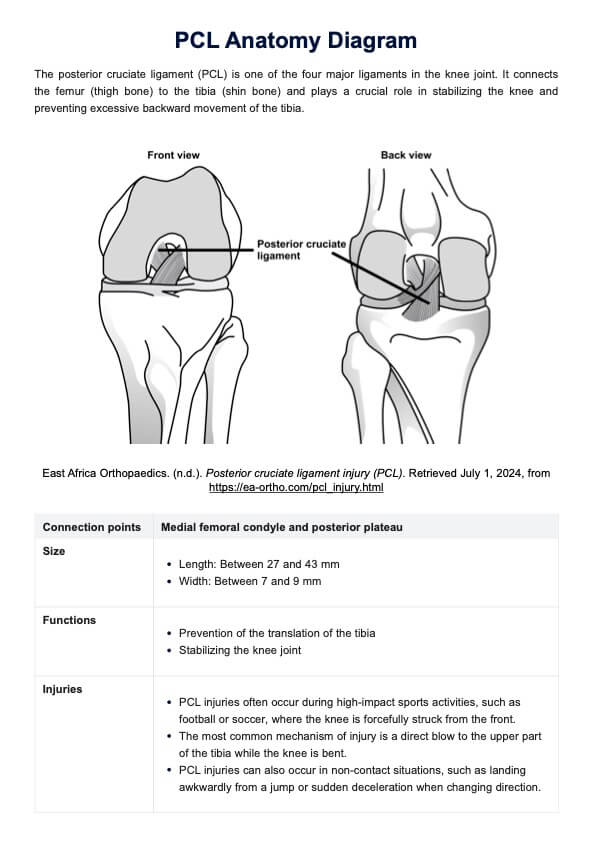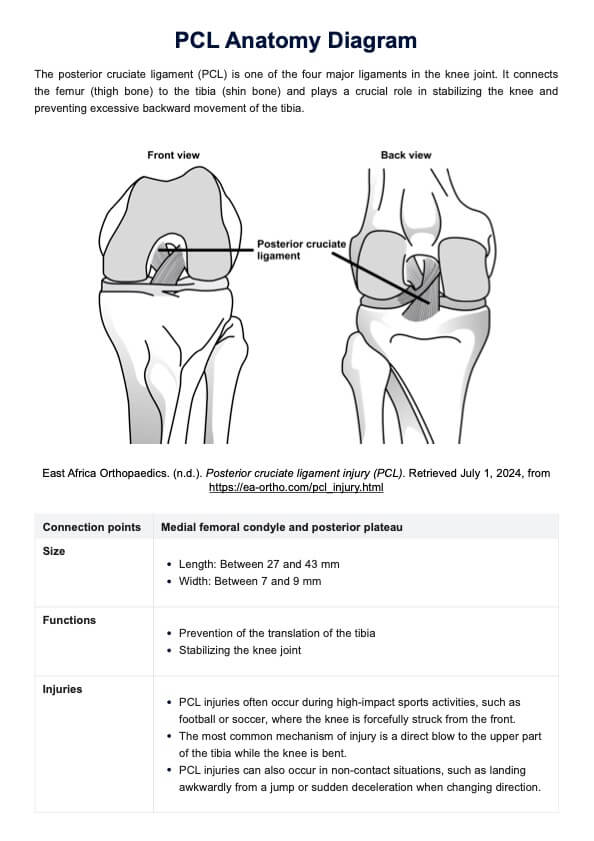PCL Anatomy Diagram
Have a visual representation of the anatomy of the posterior cruciate ligament for clinical or educational purposes by downloading our PCL Anatomy Diagram template.


What is a PCL Anatomy Diagram?
A posterior cruciate ligament (PCL) anatomy diagram illustrates the anatomy of the PCL and provides a detailed visual representation essential for comprehending the ligament's role within the knee joint. On it, one can expect to see:
- Attachments of the PCL: The diagram illustrates the PCL's connection points, which are on the medial femoral condyle of the thigh bone and posterior plateau.
- PCL interactions: With the diagram, it's better clarified how the PCL interacts with other crucial instructions like the anterior cruciate ligament (ACL) and other ligaments in the joint structure, emphasizing its position and orientation.
- Shape and size of the PCL: The diagram outlines the shape and size of the PCL, underscoring its robust nature and the critical role it plays in preventing posterior tibial translation.
- Functions of the PCL: Annotations within the diagram often detail the PCL's functions, which include preventing the posterior translation of the tibia and being one of the two cruciate ligaments stabilizing the knee joint during knee flexion.
- PCL injuries: These visuals also address the significance of posterior cruciate ligament injuries, such as posterior cruciate ligament tears that can result from sports-related trauma or other knee ligament injuries.
- PCL treatment options: Surgical interventions like PCL reconstruction are frequently depicted to illustrate treatment options and rehabilitation strategies, reinforcing the diagram's utility in educational settings and clinical practice.
Do note that the content of a PCL Anatomy Diagram can differ depending on the creator, user, or source where one obtains a copy of the diagram
PCL Anatomy Diagram Template
PCL Anatomy Diagram Example
How to use our PCL Anatomy Diagram template?
Using a PCL Anatomy Diagram template effectively involves several steps to enhance understanding and communication of the ligament's anatomy and function:
Step 1: Understanding or labeling structures
Start by understanding or labeling the key structures, such as the attachments of the PCL on the femur and tibia. It'd also be helpful to note and label the anatomic landmarks, such as the medial femoral condyle and posterior tibial plateau.
Step 2: Analyze the orientation and relationships
Consider the orientation of the PCL relative to other cruciate ligaments of the knee and illustrate how they - for example, the anterior cruciate and posterior cruciate ligaments - interact within the knee joint. Incude the joint capsule to show its relationship with the ligament.
Step 3: Outline and detail the shape and size
Outline the shape and dimensions of the PCL, providing details on its length, thickness, and how it traverses the knee joint.
Step 4: Annotate functions
Even though the functions are mentioned in our PCL Knee Anatomy Diagram Template, you can annotate and describe the functions of the PCL in the diagram.
Step 5: Use the template
Include annotations or callouts that discuss clinical relevance or utilize the diagram in educational settings to teach students or patients about knee anatomy and function. Use it as a visual aid during lectures, discussions, or patient consultations to explain complex concepts in a clear and accessible manner.
Common treatments for PCL injuries
The posterior cruciate ligament (PCL) can sustain different types of knee injuries, and the severity of the knee ligament injuries determines the treatment options. Here's an overview of the common treatments for every type of injury sustained:
- Mild or Grade 1 injuries: Any partial tear of the PCL falls under this category. Treatment commonly includes rest, ice, and the usage of a hinged knee brace and crutches.
- Moderate or Grade 2 injuries: Partial tears may also fall into this category but only if the patient experiences additional symptoms such as a loose ligament. Treatment for this is also a knee brace and crutches alongside rest and ice.
- Severe or Grade 3 injuries: Complete PCL tears that lead to knee instability fall under this category. Crutches and a hinged knee are required, and surgical options such as a PCL reconstruction may be recommended.
Commonly asked questions
Some typical symptoms include swelling, inflammation, knee instability, stiffness, difficulty in walking, and worsening pain.
Typically, they can heal on its own especially if one rests and applies ice to the area.
An ACL injury may be considered worse only because of its size and increased risk of sustaining a complete tear. However, it will still dependon the type of injury and severity one has.







































































































